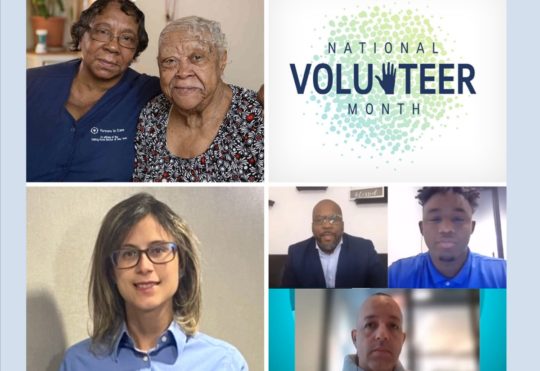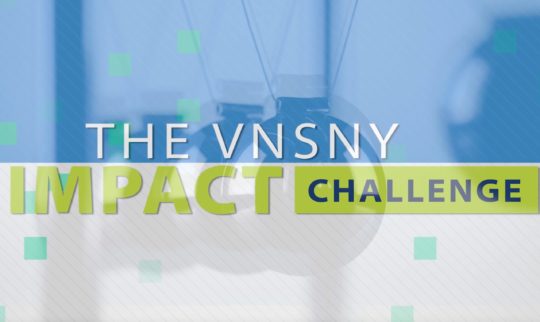An Interview with Dan Wallis, Vice President, Contact Center Shared Services
 Dan Wallis joined VNSNY in March to lead a new department called Contact Center Shared Services (CCSS). Dan comes to VNSNY after 20 years at Kaiser Permanente in California, where he oversaw a 24/7 contact center with over 400 employees serving nearly 5 million members in three states.
Dan Wallis joined VNSNY in March to lead a new department called Contact Center Shared Services (CCSS). Dan comes to VNSNY after 20 years at Kaiser Permanente in California, where he oversaw a 24/7 contact center with over 400 employees serving nearly 5 million members in three states.
Let’s start with the basics: What exactly is CCSS?
CCSS stands for Contact Center Shared Services. It’s a new department that brings together many of the contact centers within VNSNY that serve our different business units. That’s going to make for a much better experience for everyone who contacts us, and make it easier for our CCSS representatives to work with our customers.
Why are you calling it a “contact center” and not a “call center”?
“Call center” implies that people contact us only by phone. We’re upgrading our technology so that they’ll also be able to reach us by text, e-mail, or chat. Our goal is to meet the consumer where they want, when they want, how they want, and quickly and easily meet their needs.
Until now, each business controlled its own call center. Why are we making these changes?
While there were benefits to the old system, the call centers were very siloed, which prevented us from taking advantage of best practices and economies of scale inherent in a shared services model. For example, with a much bigger staff, there’s all sorts of training we can give agents, as well as technology we can adopt, that wasn’t possible with a group of smaller call centers. It also takes a burden off the department heads who oversaw the individual call centers. Now they can focus on their businesses and not be distracted by call-center issues. At the same time, CCSS will be led by contact center experts with extensive telecom experience who can get VNSNY where it needs to be in 2021.
Why are contact centers so important to VNSNY?
Contact center representatives are the first direct contact that many of our customers, and potential customers, have with VNSNY. We’re the front door to the entire organization, and our customers’ experience—good or bad—can color all their later interactions and impressions of VNSNY: A bad call can even create negative energy toward the field staff, who of course have nothing to do with the call! And a bad call can lead potential customers to simply walk away.
What kind of contact center experience do you want VNSNY to offer?
We’d like our representatives to know the customer from the minute they reach out to us – whether by phone, web or text. We want them to be able to say, “I see you called yesterday about X, and last week about Y.” And it goes without saying that we want shorter wait times, fewer transfers, and no dropped calls. Basically, we want our customers to have a frictionless experience and think, “I feel VNSNY knows me and my needs.”
What will it take for customers to have a frictionless experience?
We have 300 CCSS employees with an incredibly rich set of disciplines and skills handling 120,000 calls a month on everything from eligibility and coverage to scheduling and clinical care. We need to give them tools that allow them to help our customers as quickly and easily as possible, starting with a reliable phone system and soon a user-friendly Customer Relationship Management application (CRM) to unify the many applications we use to serve our customers. These tools will make it easier than ever to address the needs of our customers on the first call.
 How soon can we expect to see changes?
How soon can we expect to see changes?
It’s happening as we speak. In December, we rolled out a much-improved telephony platform for the contact centers called Five9. Five9’s technology is also much more reliable, and there should be a lot fewer dropped calls. And in the spring, we’ll explore alternative communication channels, such as chat, and continue looking for additional opportunities to improve workflow.
You arrived at VNSNY in March, the month when the world turned upside-down. How did the pandemic affect your work?
COVID-19 made everything more challenging, of course. But we have an incredible team, and together we all worked through it. My only regret is that I wasn’t able to sit down and watch people work. There’s no better way to learn about how people do their jobs than being attached to their hips for a couple of hours. But we compensated with lots of group calls and Zooms.
What made you want to come to VNSNY and New York?
I was actually born on Long Island, but I moved to California as a kid, before I could develop a New York accent. I’ve spent the last couple decades in San Diego, but I was happy to come back. I had always wanted to live in Manhattan, and I really like working in a mission-driven organization like VNSNY, especially when there’s a big challenge that can really make a difference. Plus, we have a two-year-old grandson in New Jersey who is undoubtedly the cutest kid on the planet, and it’s nice to be closer to him.
Since it’s December and 2020 is thankfully almost over, what can we expect from CCSS in 2021?
VNSNY’s leadership has stated that improving the consumer experience will be a key goal for 2021, and everyone in CCSS is already laser-focused on one of the most critical aspects of consumers’ interaction with VNSNY. We will be looking for opportunities to improve service to our customers by opening new channels for communication such as text or web chat. We will be exploring ways to automate some calls to give our customers instant help day or night. We will also be working with our new technology to improve the quality and safety of our service through exciting new tools like Voice Analytics. The CCSS staff has worked incredibly hard in this extremely challenging year to lay the groundwork for real change in 2021. So stay tuned!

